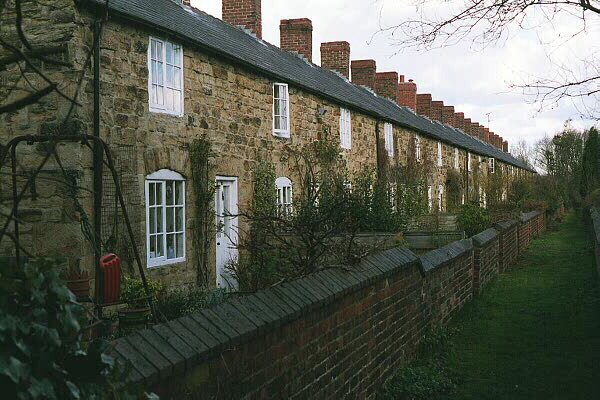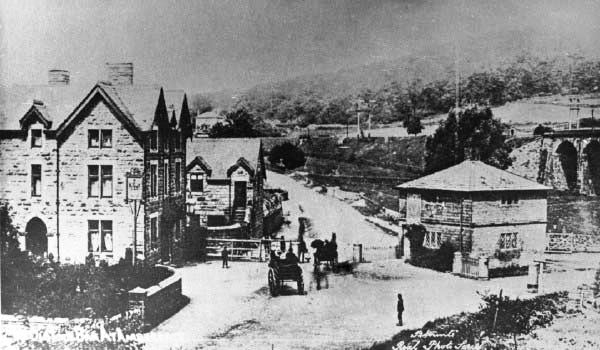|
Ironville
Ironville in Derbyshire, England, was built about 1830 by the Butterley Company as a model village to house its workers. The population of the civil parish was 1,930 at the 2021 Census. It is situated between Riddings and Codnor Park. John Wright and William Jessop had purchased the land adjacent to the Cromford Canal from Lancelot Rolleston of Watnall in 1809. The village was notable for its large gardens, and its rural setting. The Mechanics Institute was built in 1846; schools were provided in 1850 and Christ Church, Ironville, a parish church in 1852. The local authority modernised parts of the village in the late twentieth century. Nearby is Pye Hill and the bend in the Cromford Canal where it turns southward down the Erewash Valley and the junction with its extension to Pinxton. About a quarter of a mile north east is another transport landmark, Pye Bridge at the junction of the Erewash Valley railway line and the extension to Ambergate. Part of the line to Ambergate is ... [...More Info...] [...Related Items...] OR: [Wikipedia] [Google] [Baidu] |
Listed Buildings In Ironville And Riddings Ward
Ironville and Riddings is a Ward (electoral subdivision), ward in the Amber Valley district of Derbyshire, England. The ward contains 15 Listed building#England and Wales, listed buildings that are recorded in the National Heritage List for England. Of these, one is listed at Grade II*, the middle of the three grades, and the others are at Grade II, the lowest grade. The ward contains the village of Riddings, part of the model village of Ironville, and the surrounding area. In Riddings was a model farm, and buildings forming part of this are listed. Other listed buildings include a church, houses, farmhouses and associated structures, public houses, and workers' cottages along the Cromford Canal. __NOTOC__ Key Buildings See also *Listed buildings in Ironville References Citations Sources * * * * * * * * * * * * * * * * * {{DEFAULTSORT:Ironville and Riddings Ward Lists of listed buildings in Derbyshire ... [...More Info...] [...Related Items...] OR: [Wikipedia] [Google] [Baidu] |
Christ Church, Ironville
Christ Church, Ironville is a Grade II listed parish church in the Church of England in Ironville, Derbyshire. History The church was built between 1851 and 1852 to the designs of Henry Isaac Stevens for the Butterley Iron Company. It was consecrated on 16 April 1852, by the Bishop of Lichfield. Parish status The church is in a joint parish with * St James' Church, Riddings Organ A pipe organ was built by Thomas Christopher Lewis in 1876. A specification of the organ can be found on the National Pipe Organ Register. References {{DEFAULTSORT:Ironville Ironville Ironville Ironville in Derbyshire, England, was built about 1830 by the Butterley Company as a model village to house its workers. The population of the civil parish was 1,930 at the 2021 Census. It is situated between Riddings and Codnor Park. John Wrig ... Churches completed in 1852 ... [...More Info...] [...Related Items...] OR: [Wikipedia] [Google] [Baidu] |
Amber Valley
Amber Valley is a local government district and borough in the east of Derbyshire, England, taking its name from the River Amber. It covers a semi-rural zone with four main towns whose economy was based on coal mining and remains to some extent influenced by engineering, distribution and manufacturing, holding for instance the headquarters and production site of Thorntons confectionery. The seat in the House of Commons of Amber Valley is of smaller scope. The population at the 2011 Census was 122,309. The village of Crich and other parts of the district were the setting for ITV drama series ''Peak Practice''. Towns of Amber Valley *Alfreton *Belper *Heanor * Ripley Main villages of Amber Valley *Ambergate *Codnor *Crich *Denby * Duffield *Heage *Holbrook * Horsley *Horsley Woodhouse *Kedleston * Kilburn *Langley Mill * Lea & Holloway * Mackworth *Milford *Quarndon *Riddings * Smalley *Somercotes * Swanwick * Whatstandwell The district was formed on 1 April 1974 by the mer ... [...More Info...] [...Related Items...] OR: [Wikipedia] [Google] [Baidu] |
Butterley Company
The Butterley Company was an English manufacturing firm founded as Benjamin Outram and Company in 1790. Its subsidiaries existed until 2009. Origins This area of Derbyshire had been known for its outcrops of iron ore which had been exploited at least since the Middle Ages. After the Norman Conquest, nearby Duffield Frith was the property of the de Ferrers family who were iron masters in Normandy. In 1793, William Jessop, with the assistance of Benjamin Outram, constructed the Cromford Canal to connect Pinxton and Cromford with the Erewash Canal. In digging Butterley Tunnel for the Cromford Canal, coal and iron were discovered. Fortuitously, Butterley Hall fell vacant and in 1790 Outram, with the financial assistance of Francis Beresford, bought it and its estate. The following year Outram and Beresford were joined by Jessop and John, the grandson of Ichabod Wright, a wealthy Nottingham banker who was betrothed to Beresford's daughter and who owned the neighbouring Butter ... [...More Info...] [...Related Items...] OR: [Wikipedia] [Google] [Baidu] |
Cromford Canal
The Cromford Canal ran from Cromford to the Erewash Canal in Derbyshire, England with a branch to Pinxton. Built by William Jessop with the assistance of Benjamin Outram, its alignment included four tunnels and 14 locks. From Cromford it ran south following the contour line along the east side of the valley of the Derwent to Ambergate, where it turned eastwards along the Amber valley. It turned sharply to cross the valley, crossing the river and the Ambergate to Nottingham road, by means of an aqueduct at Bullbridge, before turning towards Ripley. From there the Butterley Tunnel took it through to the Erewash Valley. From the tunnel it continued to Ironville, the junction for the branch to Pinxton, and then descended through fourteen locks to meet the Erewash Canal at Langley Mill. The Pinxton Branch became important as a route for Nottinghamshire coal, via the Erewash, to the River Trent and Leicester and was a terminus of the Mansfield and Pinxton Railway. A long sect ... [...More Info...] [...Related Items...] OR: [Wikipedia] [Google] [Baidu] |
Derbyshire
Derbyshire ( ) is a ceremonial county in the East Midlands, England. It includes much of the Peak District National Park, the southern end of the Pennine range of hills and part of the National Forest. It borders Greater Manchester to the north-west, West Yorkshire to the north, South Yorkshire to the north-east, Nottinghamshire to the east, Leicestershire to the south-east, Staffordshire to the west and south-west and Cheshire to the west. Kinder Scout, at , is the highest point and Trent Meadows, where the River Trent leaves Derbyshire, the lowest at . The north–south River Derwent is the longest river at . In 2003, the Ordnance Survey named Church Flatts Farm at Coton in the Elms, near Swadlincote, as Britain's furthest point from the sea. Derby is a unitary authority area, but remains part of the ceremonial county. The county was a lot larger than its present coverage, it once extended to the boundaries of the City of Sheffield district in South Yorkshire where it cov ... [...More Info...] [...Related Items...] OR: [Wikipedia] [Google] [Baidu] |
Model Village
A model village is a type of mostly self-contained community, built from the late 18th century onwards by landowners and business magnates to house their workers. Although the villages are located close to the workplace, they are generally physically separated from them and often consist of relatively high-quality housing, with integrated community amenities and attractive physical environments. "Model" is used in the sense of an ideal to which other developments could aspire. British Isles The term model village was first used by the Victorians to describe the new settlements created on the rural estates of the landed gentry in the eighteenth century. As landowners sought to improve their estates for aesthetic reasons, new landscapes were created and the cottages of the poor were demolished and rebuilt out of sight of their country house vistas. New villages were created at Nuneham Courtenay when the village was rebuilt as plain brick dwellings either side of the main road, ... [...More Info...] [...Related Items...] OR: [Wikipedia] [Google] [Baidu] |
William Jessop
William Jessop (23 January 1745 – 18 November 1814) was an English civil engineer, best known for his work on canals, harbours and early railways in the late 18th and early 19th centuries. Early life Jessop was born in Devonport, Devon, the son of Josias Jessop, a foreman shipwright in the Naval Dockyard. Josias Jessop was responsible for the repair and maintenance of Rudyerd's Tower, a wooden lighthouse on the Eddystone Rocks, Eddystone Rock. He carried out this task for twenty years until 1755, when the lighthouse burnt down. John Smeaton, a leading civil engineer, drew up plans for a new stone lighthouse and Josias became responsible for the overseeing the building work. The two men became close friends, and when Josias died in 1761, two years after the completion of the lighthouse, William Jessop was taken on as a pupil by Smeaton (who also acted as Jessop's guardian), working on various canal schemes in Yorkshire.Rolt, L.T.C., "Great Engineers", 1962, G. Bell and Sons Ltd ... [...More Info...] [...Related Items...] OR: [Wikipedia] [Google] [Baidu] |
Erewash Valley
The Erewash Valley is the valley of the River Erewash (pronounced ) on the border of Derbyshire and Nottinghamshire as far as the River Trent. It runs along the boundary of the southern end of the Derbyshire hills and the more rolling Nottinghamshire country. It is on the edge of an area of great mineral wealth, particularly coal, extending from Yorkshire to Leicestershire. Industrial Importance It has long been an important transport route, with the Erewash Canal being built from the River Trent to Langley Mill in 1779, extended by the Cromford Canal in 1794 with a branch to Pinxton, where it was later joined by the Mansfield and Pinxton Railway in 1819. Later the Midland Railway built a connection from its line at Trent Junction to the Mansfield and Pinxton, and onward to Chesterfield, which has become known as the '' Erewash Valley Line.'' The valley contains the Grade II* listed disused wrought iron Bennerley Viaduct which once carried the GNR Derbyshire and Staffordshire ... [...More Info...] [...Related Items...] OR: [Wikipedia] [Google] [Baidu] |
Pinxton
Pinxton is a village and civil parish in Derbyshire on the eastern boundary of Nottinghamshire, England, just south of the Pinxton Interchange at Junction 28 of the M1 motorway where the A38 road meets the M1. Pinxton is part of the Bolsover District and at the 2011 Census had a population of 5,699. "Pinxton CCTV level crossing", located on the up and down Kirkby lines, is a major tourist attraction for train enthusiasts who come from all over the country to take photographs of some of the unique locomotives that pass over the crossing. History Etymology In Anglo-Saxon times, Pinxton was a small agricultural community, thought to have been recorded in the Domesday Book of 1086 as "Esnotrewic." It is also thought that it was known as "Snodeswic," given by Wulfric Spott to Burton Abbey. In Norman times, along with a number of other manors, it was under the control of William Peveril, for whom it was held by Drogo fitz Pons. It is thought that he renamed the manor "Ponceston" ... [...More Info...] [...Related Items...] OR: [Wikipedia] [Google] [Baidu] |
Ambergate
Ambergate is a village in Derbyshire, England, situated where the River Amber joins the River Derwent, and where the A610 road from Ripley and Nottingham joins the A6 that runs along the Derwent valley between Derby to the south and Matlock to the north. Sawmills and Ridgeway are neighbouring hamlets, and Alderwasley, Heage, Nether Heage and Crich are other significant neighbouring settlements. The village forms part of the Heage and Ambergate ward of Ripley Town Council with a population of 5,013 at the 2011 Census. Ambergate is within the Derwent Valley Mills UNESCO World Heritage site, and has historical connections with George Stephenson; Ambergate is notable for its railway heritage and telephone exchange. Ambergate has an active community life, particularly centred on the school, pubs, churches, sports clubs; and annual village carnival which is relatively large and consistent locally, with popular associated events in carnival week and throughout the year. The carniv ... [...More Info...] [...Related Items...] OR: [Wikipedia] [Google] [Baidu] |
_(14593075978)_(cropped).jpg)






